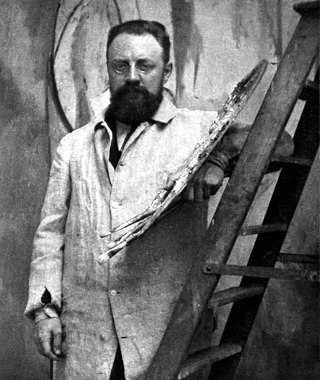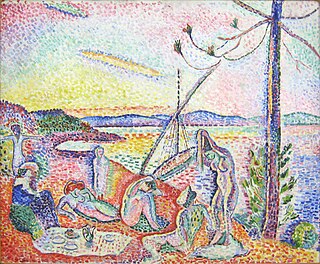Related Research Articles

Pierre Brissaud was a French Art Deco illustrator, painter, and engraver. He was born in Paris and trained at the École des Beaux-Arts and Atelier Fernand Cormon in Montmartre, Paris. His father was Dr. Édouard Brissaud, a student of Dr. Jean-Martin Charcot. His fellow students at Cormon were his brother Jacques, André-Édouard Marty, Charles Martin, and Georges Lepape. Students at the workshop drew, painted and designed wallpaper, furniture and posters. Earlier, Toulouse-Lautrec, van Gogh, and Henri Matisse had studied and worked there. Pierre's older brother Jacques Brissaud was a portrait and genre painter and his uncle Maurice Boutet de Monvel illustrated the fables of La Fontaine, songbooks for children and a life of Joan of Arc. A first cousin was the celebrated artist and celebrity portrait painter Bernard Boutet de Monvel.

Henri Émile Benoît Matisse was a French visual artist, known for both his use of colour and his fluid and original draughtsmanship. He was a draughtsman, printmaker, and sculptor, but is known primarily as a painter. Matisse is commonly regarded, along with Pablo Picasso, as one of the artists who best helped to define the revolutionary developments in the visual arts throughout the opening decades of the twentieth century, responsible for significant developments in painting and sculpture.

Minotaure was a Surrealist-oriented magazine founded by Albert Skira and E. Tériade in Paris and published between 1933 and 1939. Minotaure published on the plastic arts, poetry, and literature, avant garde, as well as articles on esoteric and unusual aspects of literary and art history. Also included were psychoanalytical studies and artistic aspects of anthropology and ethnography. It was a lavish and extravagant magazine by the standards of the 1930s, profusely illustrated with high quality reproductions of art, often in color.
Tériade is the pen name of StratisEleftheriades, a native of Mytilene who went to Paris in 1915 at the age of eighteen to study law, but who instead became an art critic, patron, and, most significantly, a publisher.

The Painter and His Model is a work by Henri Matisse painted late 1916, early 1917. It is currently in the collection of the Musée National d'Art Moderne, Centre Georges Pompidou, Paris. In this work Matisse depicted himself in his studio on the fourth floor of 19 Quai Saint-Michel, at work on his painting Laurette in a Green Robe (1916).
Gaston Diehl was a French professor of art history and an art critic.

Luxe, Calme et Volupté is a 1904 oil painting by the French artist Henri Matisse. Both foundational in the oeuvre of Matisse and a pivotal work in the history of art, Luxe, Calme et Volupté is considered the starting point of Fauvism. This painting is a dynamic and vibrant work created early on in his career as a painter. It displays an evolution of the Neo-Impressionist style mixed with a new conceptual meaning based in fantasy and leisure that had not been seen in works before.

Mildred Bendall was an active force of the avant-garde in Bordeaux, and instrumental in building a real exchange with Paris.

Fauvism is the style of les Fauves, a group of early 20th-century modern artists whose works emphasized painterly qualities and strong colour over the representational or realistic values retained by Impressionism. While Fauvism as a style began around 1904 and continued beyond 1910, the movement as such lasted only a few years, 1905–1908, and had three exhibitions. The leaders of the movement were André Derain and Henri Matisse.
Éric Alibert is a French painter, specialising in nature and animals. He is also the author of books dedicated to several important natural sites of the world. He uses watercolour, oil, acrylic as well as other techniques including the use of gold leaves.
Akiya Takahashi is a Japanese art historian and a founding director of the Mitsubishi Ichigokan Museum, Tokyo.
The Galerie Barbazanges was an art gallery in Paris that exhibited contemporary art between 1911 and 1928. The building was owned by a wealthy fashion designer, Paul Poiret, and the gallery was used for Poiret's "Salon d'Antin" exhibitions. The gallery showed the work of avant-garde artists such as Picasso, Modigliani, Gauguin, Matisse, Chagall, and Dufy.

ORAZI, was born in 1906 and died in 1979. He was a painter of the French School, mentioned as a member of the School of Paris.
Gustave Achille Gaston Migeon was a French historian of the arts of the world.

Raymond Escholier, real name Raymond-Antoine-Marie-Emmanuel Escolier, was a French journalist, novelist and art critic. He was curator of the Maison de Victor Hugo and of the Petit Palais.

Henri Cueco was a French painter, essayist, novelist and radio personality. As a self-taught painter, his work was exhibited internationally. He was the author of several books, including collections of essays and novels. He was also a contributor to France Culture. A communist-turned-libertarian, he was a co-founder of Coopérative des Malassis, an anti-consumerist artists' collective. He was best known for The Red Men, a series of figurative paintings depicting aspects of the Cold War like the May 1968 events, the Vietnam War and Red Scare, and his 150 still lifes, or "portraits," of potatoes.

Raoul Albert La Roche was a Swiss banker and art collector. He was especially interested in purism and cubism and his collections have been donated to museums in Switzerland and France. His home in Paris, Maison La Roche, was designed by his friend Le Corbusier and now houses the Le Corbusier Foundation.

Michel Ragon was a French art and literature critic and writer. His primary focus was on anarchic and libertarian literature.

The Maison Moos, later called the Galerie Moos, was an art gallery and auction house founded in 1906 in Geneva by the art dealer Max Moos. The gallery closed in 1976.

Maurice Paul Jean Asselin was a French painter, watercolourist, printmaker, lithographer, engraver and illustrator, associated with the School of Paris. He is best known for still lifes and nudes. Other recurring themes in his work are motherhood, and the landscapes and seascapes of Brittany. He also worked as a book illustrator, particularly in the 1920s. His personal style was characterised by subdued colours, sensitive brushwork and a strong sense of composition and design.
References
- 1 2 3 4 5 6 7 8 9 Cubicciotti, Amy. "Pierre Courthion Biography" (PDF). Getty Research Institute . Retrieved July 29, 2023.
- 1 2 3 4 "Pierre Courthion papers". Getty Research Institute . Retrieved 14 November 2020.
- 1 2 Cone, Michele (14 June 2013). "Killed by Matisse in 1941, Courthion's Interviews Are Resurrected". artinamericamagazine.com. Retrieved 2 May 2019.
- 1 2 "Chatting With Henri Matisse (HB)". National Gallery Shop. Retrieved 2 May 2019.